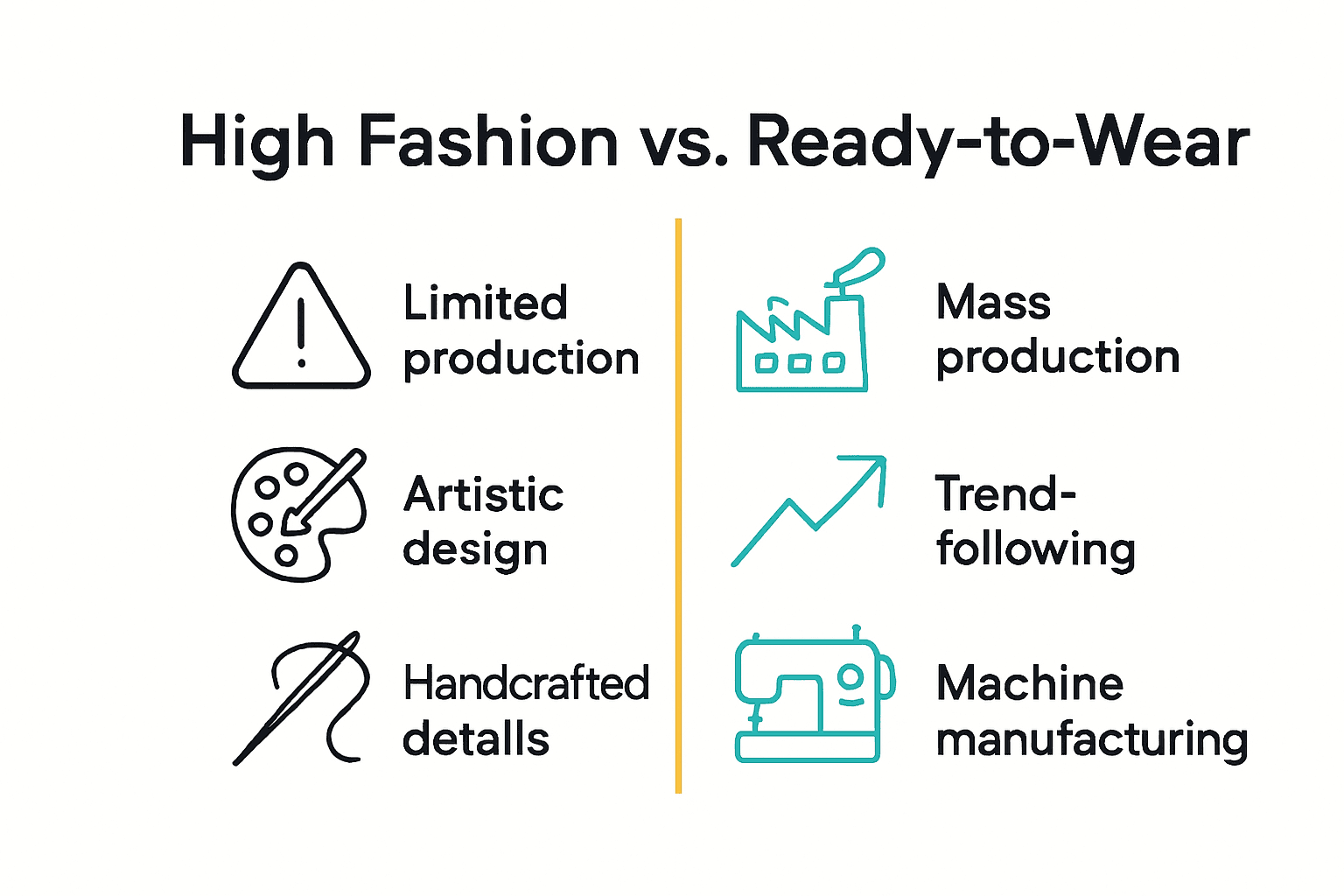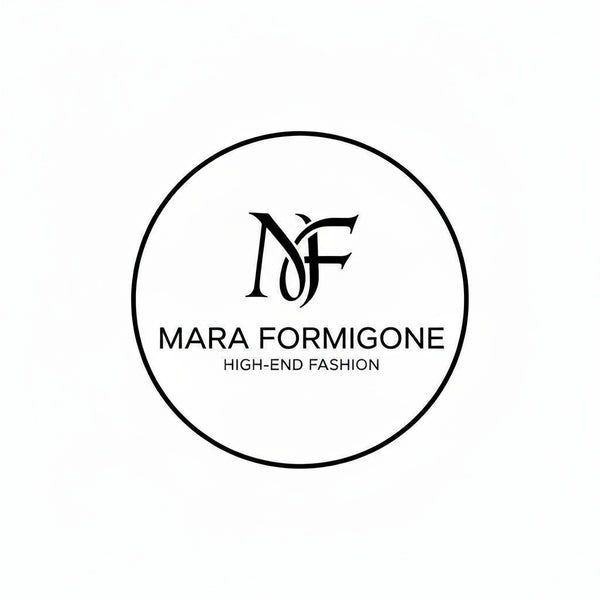Over 80 percent of people believe high fashion is just about expensive clothes, yet true luxury goes much deeper than price. High fashion is a world where craftsmanship, artistry, and bold innovation all meet to create statement pieces that shape culture itself. This guide shines a light on what actually defines high fashion, clears up common myths, and reveals why designer labels have such lasting cultural impact.
Table of Contents
- Defining High Fashion and Common Misconceptions
- Key Elements and Iconic Designer Labels
- Evolution of High Fashion Trends
- How High Fashion Differs From Ready-to-Wear
- Cost, Accessibility, and Collectibility Factors
Key Takeaways
| Point | Details |
|---|---|
| High Fashion as Art | High fashion transcends clothing, serving as a medium for personal and cultural expression through innovative design and exceptional craftsmanship. |
| Democratization of Luxury | Emerging designers are redefining accessibility in high fashion, creating quality pieces across various price ranges while challenging traditional luxury norms. |
| Cultural Commentary | Fashion trends reflect complex social dialogues, with high fashion acting as a platform for cultural critique and identity transformation through its designs. |
| Collectibility Factors | The value of high fashion extends beyond price, relying on artistry, rarity, and cultural significance, making certain pieces desirable investments for collectors. |
Defining High Fashion and Common Misconceptions
High fashion represents far more than expensive clothing hanging on designer racks. Haute couture is a complex artistic landscape where creativity, craftsmanship, and innovation converge to produce extraordinary garments that transcend traditional fashion boundaries. According to research from Tennessee Tech University, luxury fashion is characterized by profound themes like dreams, exclusivity, and artistic expression, operating on fundamentally different design principles compared to mass market clothing.
Contrary to popular belief, high fashion isn’t exclusively defined by astronomical price tags. As insights from 3 Clicks Cloud reveal, high fashion is fundamentally about innovation, creativity, and exceptional craftsmanship. Emerging designers are challenging traditional perceptions by creating quality pieces across diverse price ranges, democratizing access to sophisticated design.
Key characteristics that distinguish high fashion include:
- Exceptional design complexity
- Handcrafted precision
- Unique conceptual narratives
- Limited production quantities
- Experimental materials and techniques
Understanding high fashion requires recognizing it as an art form where clothing becomes a medium for personal expression and cultural commentary. These garments aren’t mere fabric assemblages but carefully constructed statements that reflect broader aesthetic, social, and creative movements. The most compelling high fashion pieces tell stories, challenge conventions, and transform how we perceive personal style and cultural identity.
Key Elements and Iconic Designer Labels
High fashion transcends mere clothing, representing a sophisticated blend of artistic vision, cultural expression, and exceptional craftsmanship. According to research from Elevated Magazines, iconic fashion brands are defined by seven critical elements: a compelling brand story, distinctive visual identity, clear market positioning, innovative design philosophy, strategic marketing, exceptional customer experience, and remarkable adaptability.
Designer labels like Chanel, Alexander McQueen, and Balenciaga exemplify these principles through their unique approaches. As insights from Fashionide reveal, true iconic status emerges from a combination of innovation, risk-taking, quality craftsmanship, authentic storytelling, and a commitment to pushing creative boundaries. These brands don’t just create clothing - they craft cultural narratives that resonate deeply with their audiences.
Key characteristics of legendary designer labels include:
- Consistent brand DNA
- Groundbreaking design philosophies
- Cultural and artistic relevance
- Technical mastery of garment construction
- Ability to anticipate and shape fashion trends
Beyond aesthetics, iconic designer labels represent complex ecosystems of creativity. They transform fabric into statements, challenge conventional beauty standards, and serve as cultural touchstones that reflect broader societal movements.
 Each collection becomes a nuanced dialogue between tradition and innovation, inviting audiences to reimagine personal style as a form of artistic self-expression.
Each collection becomes a nuanced dialogue between tradition and innovation, inviting audiences to reimagine personal style as a form of artistic self-expression.
For those passionate about understanding high fashion’s intricate world, exploring our comprehensive guide to fashion heritage can provide deeper insights into the rich tapestry of designer creativity.
Evolution of High Fashion Trends
Fashion trends are far more than cyclical clothing transformations - they represent complex social dialogues where aesthetics, cultural movements, and power dynamics intersect. Research from ArXiv reveals a fascinating mechanism of trend evolution, demonstrating how fashion changes are driven by counter-dominance signaling, a process where peripheral social groups challenge established aesthetic norms by introducing contrasting symbolic representations.
Historically, high fashion has been a powerful platform for social commentary and rebellion. Each era’s trends reflect deeper sociopolitical narratives - from Christian Dior’s revolutionary New Look challenging post-war austerity to punk fashion’s aggressive rejection of mainstream cultural expectations. These movements aren’t random but strategic expressions of cultural identity, where clothing becomes a nuanced language of resistance and transformation.
Key evolutionary stages of high fashion trends include:
- Emergence from elite cultural circles
- Gradual democratization and accessibility
- Reinterpretation by subcultures
- Global cross-cultural hybridization
- Technological and sustainable innovation
Contemporary high fashion increasingly embraces fluidity, breaking traditional boundaries of gender, culture, and aesthetic perception. Designers now view fashion as a dynamic, interactive medium that transcends mere clothing, incorporating technological innovations, sustainable practices, and profound social narratives. Each collection becomes a provocative statement, challenging viewers to reimagine personal and collective identity through visual storytelling.
To explore the intricate relationship between fashion and cultural movements, check out our comprehensive guide on the role of fashion trends, which delves deeper into these transformative processes.
How High Fashion Differs From Ready-to-Wear
The distinction between high fashion and ready-to-wear is far more profound than simply price or accessibility. According to research from Tennessee Tech University, luxury fashion operates on fundamentally different principles, emphasizing themes of dreams, exclusivity, and artistic expression through slower, more intentional design cycles that radically contrast with mass production approaches.
Ready-to-wear clothing primarily focuses on rapid trend replication and broad market appeal, while high fashion represents a deeply conceptual art form. As insights from 3 Clicks Cloud reveal, high fashion transcends mere trend following, instead valuing timeless styles, personal expression, and profound cultural narratives that transform clothing into complex cultural statements.
Key differences between high fashion and ready-to-wear include:
- Production scale (limited vs. mass)
- Design complexity (conceptual vs. functional)
- Creative intent (artistic expression vs. market demand)
- Material selection (rare, experimental vs. standardized)
- Manufacturing techniques (handcrafted vs. machine-produced)
High fashion represents an intricate dialogue between designer and audience, where each garment becomes a provocative statement challenging conventional aesthetic boundaries. Unlike ready-to-wear’s emphasis on immediate consumption, these pieces invite contemplation, revealing layers of cultural meaning beyond surface-level visual appeal. The runway becomes a stage for cultural critique, with designers using fabric, form, and texture to communicate complex narratives about identity, social dynamics, and human experience.

To explore the nuanced world of fashion design further, delve into our comprehensive guide on the role of fashion trends, which offers deeper insights into these transformative creative processes.
Cost, Accessibility, and Collectibility Factors
High fashion challenges traditional perceptions of luxury, demonstrating that value extends far beyond monetary price tags. According to insights from 3 Clicks Cloud, the industry is increasingly defined by innovation and craftsmanship rather than exclusive pricing, with emerging designers creating high-quality pieces accessible across various economic ranges.
Research from Fashionide highlights that collectibility in high fashion emerges from superior quality, artistry, and ethical production practices. Consumers increasingly view luxury fashion as an investment, seeking pieces that transcend temporary trends and represent meaningful cultural and artistic statements. The most collectible items often embody unique design narratives, exceptional craftsmanship, and limited production runs.
Key factors influencing high fashion’s cost and collectibility include:
- Artisan manufacturing techniques
- Rare and experimental materials
- Historical and cultural significance
- Designer’s reputation and creative legacy
- Limited edition or runway-exclusive status
Accessibility in high fashion has dramatically transformed, moving beyond traditional elite boundaries. Contemporary designers are creating more inclusive pathways, offering diffusion lines, digital experiences, and collaborative collections that democratize luxury fashion. These strategies allow broader audiences to engage with high-end design philosophies, bridging the gap between exclusive runway presentations and everyday fashion consumption.
For those intrigued by the intricate world of fashion design and trends, explore our comprehensive guide on the role of fashion trends, which provides deeper insights into this dynamic cultural landscape.
Discover the True Essence of High Fashion with MaraFormigone
Understanding the artistry behind high fashion can feel overwhelming when faced with fast fashion and fleeting trends. This article reveals how high fashion is an art form driven by creativity, exclusivity, and profound cultural narratives. If you want to experience this refined world firsthand, MaraFormigone offers a curated selection of luxury designer pieces that embody innovation, craftsmanship, and timeless style.

Elevate your wardrobe now by exploring our exclusive collection at MaraFormigone. Every piece reflects the key elements discussed in the guide whether it be the handcrafted details or bold design philosophies. Do not miss your chance to own garments that tell a story and make an unforgettable statement. Start your journey into authentic high fashion today and transform your style with confidence.
Frequently Asked Questions
What is the difference between high fashion and ready-to-wear?
High fashion is characterized by its limited production, complex designs, and artistic expression, whereas ready-to-wear focuses on mass production and broad market appeal, prioritizing immediate consumption over conceptual creativity.
What are the key elements that define iconic high fashion brands?
Iconic high fashion brands are defined by a compelling brand story, distinctive visual identity, clear market positioning, innovative design philosophy, strategic marketing, exceptional customer experience, and remarkable adaptability.
How does high fashion impact cultural identity and expression?
High fashion serves as a powerful medium for cultural commentary, where clothing becomes a statement that reflects broader societal movements and personal identity, challenging traditional beauty standards and aesthetic norms.
Why is craftsmanship important in high fashion?
Craftsmanship is crucial in high fashion as it emphasizes exceptional quality, artistic vision, and the use of unique materials, contributing to the value and collectibility of high fashion pieces that often become cultural and artistic artifacts.

